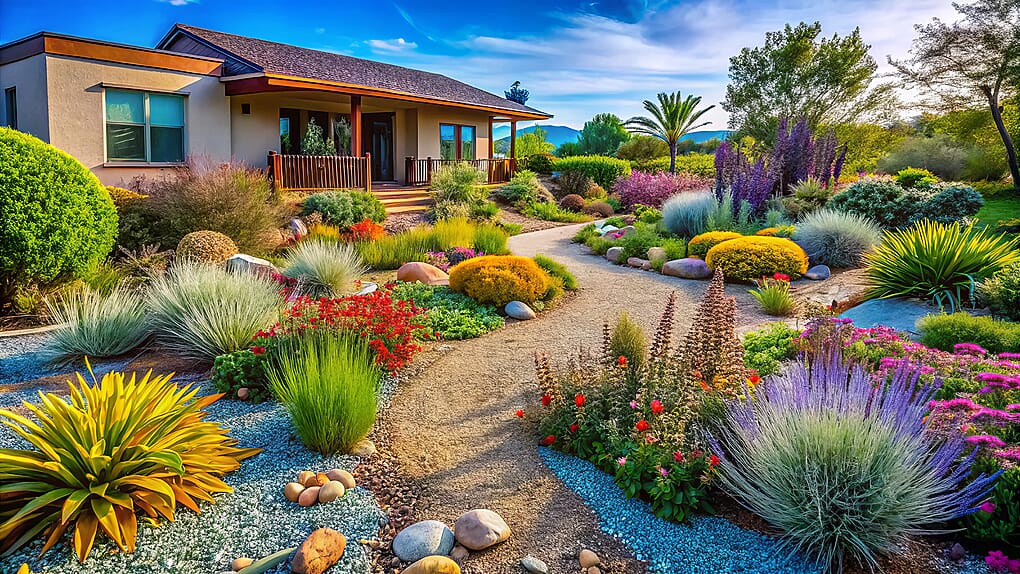Blog
Proven Tips for a Water-Efficient Garden: Save Water and Grow Healthier Plants
In today’s world, water is no longer a limitless resource we can take for granted. From the prolonged droughts in the western United States to unpredictable rainfall patterns across the globe, gardeners and homeowners are increasingly called to rethink how they use water outdoors. Irrigation systems like drip lines and smart controllers have already transformed the way we manage water in landscapes, but there is so much more we can do.
A thriving garden doesn’t have to come at the expense of water efficiency. In fact, some of the most beautiful and resilient landscapes are built on principles of conservation. With a few intentional strategies, you can reduce waste, save money on your water bill, and create a healthier space for plants and better for the environment.
Below are nine powerful practices that go beyond the basics, helping you design and maintain a water-wise garden that truly thrives.
1. Enhance Your Soil
Healthy soil is the foundation of a water-efficient landscape. Soil rich in organic matter acts like a sponge, holding water in place and releasing it slowly to plant roots. By amending your garden beds with compost, leaf mold, or aged manure, you improve both the structure and water-holding capacity of the soil.
Good soil doesn’t just reduce the need for frequent irrigation; it also minimizes runoff during heavy rains and makes nutrients more available to plants. Over time, this means your garden becomes more self-sustaining, requiring fewer inputs and less maintenance.
Pro Tip: Incorporate compost at least once a year, and don’t be afraid to leave grass clippings or shredded leaves in place as natural soil builders.
2. Optimize Plant Spacing
Overcrowding plants is one of the easiest ways to waste water. When too many plants compete for limited moisture, weaker ones suffer while the stronger ones overconsume. By giving each plant the right amount of space, you ensure root systems have room to expand and access water efficiently.
Thoughtful spacing also improves airflow, which reduces plant stress and lowers the risk of disease, another factor that indirectly affects water use. A healthy, well-spaced plant uses water more efficiently than one constantly battling pests or fungus.
Pro Tip: When in doubt, follow the spacing guidelines on plant tags. They’re not just for looks, they’re written with water and nutrient needs in mind.
3. Harness Windbreaks and Microclimates
Wind is a silent thief of soil moisture. Strong gusts can strip water from leaves and accelerate evaporation from the soil surface. Installing windbreaks, whether through fencing, hedges, or strategic plantings, creates a buffer that keeps moisture where it belongs.
Beyond wind protection, thoughtful design can help you create microclimates within your garden. Grouping water-loving plants in sheltered, shaded areas while placing drought-tolerant species in sunnier, exposed spots ensures each plant thrives with the water it needs.
Pro Tip: Evergreen hedges make excellent windbreaks, offering year-round protection and habitat for wildlife.
4. Master the Magic of Mulch
Mulch is one of the simplest, most effective water-saving tools at your disposal. A 2–3 inch layer of organic mulch, such as wood chips, bark, or straw, helps lock moisture into the soil, keeps roots cool, and suppresses thirsty weeds.
You can even get creative: compost used as mulch adds nutrients while conserving water, giving you a double benefit. Over time, mulch breaks down and improves soil quality, too.
Pro Tip: Keep mulch a few inches away from plant stems to prevent rot and pests.
5. Choose Native and Adaptive Plants
Not all plants are created equal when it comes to water needs. Native plants and regionally adaptive species are already tuned to thrive in your local climate. They’ve evolved to withstand seasonal droughts, heat, and rainfall patterns without demanding extra water.
By incorporating native flora, you’re not only reducing irrigation demands, you’re also supporting pollinators and biodiversity in your area. Imagine a garden alive with hummingbirds, bees, and butterflies, all flourishing alongside resilient, low-maintenance plants.
Pro Tip: Visit a local native plant nursery or cooperative extension office to find species best suited for your region.
6. Commit to Regular Maintenance
Even the most efficient irrigation system can’t compensate for a neglected garden. Weeds are water thieves, pulling moisture away from your chosen plants. Dead foliage not only wastes nutrients but can also harbor pests.
By pruning, weeding, and removing debris regularly, you direct water resources where they’re most needed. Healthy plants require less water because they’re not stressed or competing for resources.
Pro Tip: Spend 15 minutes a week on light maintenance; it will save you hours (and gallons of water) down the road.
7. Group Plants by Water Needs
This strategy, known as hydrozoning, is a game-changer for water efficiency. Instead of watering your entire garden the same way, group plants with similar requirements together. Place thirsty vegetables in one bed, drought-tolerant ornamentals in another, and shade-loving perennials elsewhere.
This allows you to fine-tune irrigation and avoid wasting water on plants that don’t need it. It’s a simple shift that makes your watering more precise and effective.
Pro Tip: Use drip irrigation or smart controllers to customize watering schedules for each zone.
8. Embrace Smart Technology
Smart irrigation controllers, soil moisture sensors, and weather-based systems are no longer “extras”; they’re essential for anyone serious about water conservation. These tools adjust watering schedules based on real-time conditions, preventing overwatering and reducing waste.
Pairing smart technology with the strategies above gives you the ultimate efficiency: a system that responds to your garden’s unique needs.
Pro Tip: Look for EPA WaterSense–certified smart controllers for proven savings.
9. See Your Garden as Part of the Bigger Picture
When you conserve water in your landscape, you’re not just helping your plants, you’re contributing to a more sustainable future. Each gallon saved reduces strain on local reservoirs, cuts energy costs for water delivery, and supports healthier ecosystems.
A water-efficient garden is a statement: beauty doesn’t have to come at the expense of the environment. It’s proof that thoughtful design and care can create spaces that inspire, nourish, and endure.
The Bottom Line
By enhancing soil, spacing plants wisely, creating microclimates, mulching, selecting native plants, maintaining regularly, hydrozoning, and embracing smart technology, you set the stage for a garden that thrives with less water. These strategies aren’t just about saving resources — they’re about building resilience.

